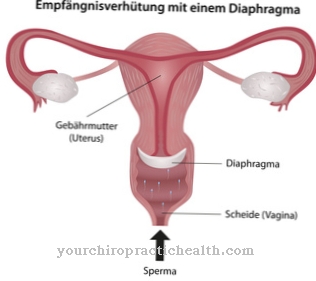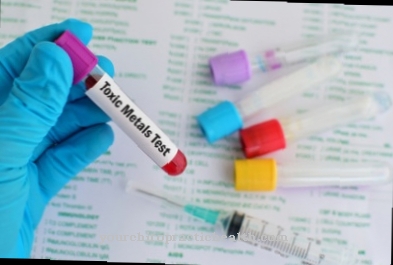As Angioscopy This is a virtual, direct or endoscopic view of vessels, with the biliary tract or blood vessels being examined in particular.
What is angioscopy?

Angioscopy is a diagnostic procedure with which vessels can be viewed directly or indirectly. The term is mainly used for an endoscopic examination of blood vessels.
Depending on the technology, a distinction is made between conventional angioscopy, in which the vessels are directly visually observed with a special catheter, virtual angioscopy, which shows the vessels in 3D, and capillary microscopy, with the help of which blood capillaries close to the surface can be examined.
Function, effect & goals
In conventional angioscopy, a miniature catheter is used that has fiber optics or a light source. The catheter is introduced into the respective vessel through a vascular incision via a guide wire and a sheath, after which the angioscope is also advanced.
This is connected to a camera that records images from the blood vessels. Rinsing with a saline solution ensures a clear view of the inner walls of the vessels. With the help of conventional angioscopy, atherosclerotic changes in vascular walls and vascular stenoses can be assessed. The following vascular regions are well suited for angioscopy:
- Pelvic leg arteries
- Pelvic leg veins
- Coronary arteries
- Dialysis shunts
Extreme light intensities are required so that a vessel can be illuminated homogeneously. Xenon vapor lamps are mainly used here, because insufficient illumination can significantly impair the image quality in terms of resolution, depth of field or color. There are around 3,000 glass fibers in the inner catheter, through which the light is subsequently guided to the tip of the catheter.
The outer sheath makes it possible to move the inner catheter back and forth so that the vessel walls and the vessel lumen can be inspected. The tip of the catheter has a lens that widens the field of view by 45 degrees. Video documentation is important in order to be able to record floating plaques or thrombi. In addition, a scene can be viewed several times after angioscopy. The catheter guides the angioscope directly to the lesion to be examined, without damaging the vessel walls.
It also ensures maximum flushing flow and optimal visibility. If the inner walls of the coronary vessels are to be examined, one speaks of a coronary angioscopy. A coronary angioscope is inserted into the arterial system via the brachial artery or the femoral artery and brought into the respective coronary artery with the help of a guide wire. Then you close the vessel for about 30 seconds with an occlusion balloon and rinse it with warm Ringer's lactate solution in order to be able to move the optics. At the same time, the image sequence is recorded on the hard drive or video until sufficient meaningful image material is available.
With a coronary angioscopy, the inner walls of the vessels can be viewed and any changes assessed. This examination method primarily assesses the surface morphology of coronary lesions. For example, you can differentiate between white and yellow plaque and make a statement about the success of a PTCA (percutaneous transluminal coronary angioplasty). With the help of angioscopy, the biliary tract can also be examined. This makes it possible to visualize the biliary tract or the pancreatic duct in order to identify pathological changes in the gallbladder, liver or pancreas at an early stage and to be able to select an appropriate treatment method.
A cholangioscopy is performed, for example, to diagnose cholangitis, suspected tumors, papillary stenosis, duct lesions or an inexplicable jaundice. This form of inspection was made possible by the development of mother-baby endoscopy and the introduction of the cholangioscope (baby endoscope). As part of a cholangioscopy, the examiner inserts a very thin endoscope with a camera into the pancreatic or bile ducts, which enables the mucous membrane to be examined visually. Today, cholongioscopy is used as a complementary diagnostic method to other methods such as MRI, CT or ultrasound. The possible uses are extremely varied and, in addition to visual diagnostics, also allow a biopsy and targeted therapy in the area of the biliary tract.
Risks, side effects & dangers
The miniaturization of the catheter has made it much easier to perform an angioscopy. In theory, angioscopy can be performed in any arterial or venous vessel. However, there are also limits due to the diameter of the vessel. The lower limit is a diameter of 1mm, the upper limit of the range of applications is limited by illuminability and light intensity.
Vessels with a diameter of 2 to 8 mm are ideal. An angioscopy becomes difficult when the vessel meanders very strongly. However, if the angioscope is used correctly, there are normally no vascular perforations or aneurysms. However, so-called flaps often occur due to the forward and backward movement. But there are also a number of risks that make a cholangioscopy complicated or impossible. These include high-grade stenoses, biliary strictures or previous surgical intervention in the stomach area. Possible complications that can occur with a cholangioscopy are:
- small bleeding
- Abdominal pain that lasts for more than a day
- excessive accumulation of gas in the gastrointestinal tract
- mild pancreatitis
- Cholangitis (inflammation of the bile ducts)
- perforation
Coronary angioscopy is considered a very safe examination method. Complications are rather isolated cases that can include an acute myocardial infarction or an acute vascular occlusion. Coronary occlusions can also cause EKG changes or anginal symptoms.



























